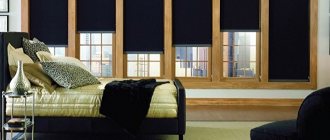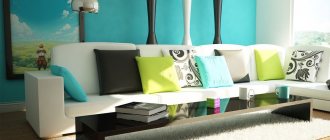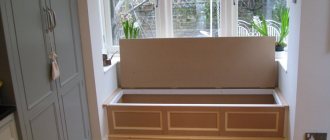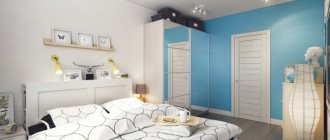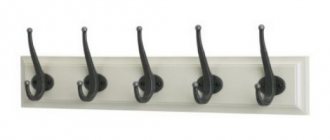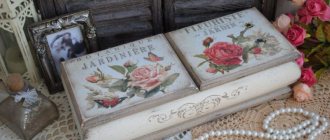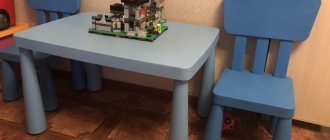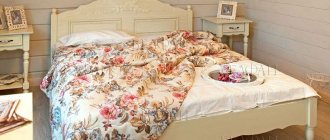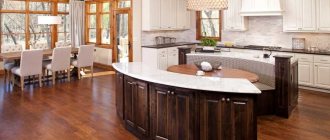Furniture (from the Latin mobile - “movable”) is the collective name for movable and built-in room furnishings that are located in residential or public spaces. Furniture not only provides comfort to people's daily lives, but is also an important part of interior decoration. It is also often used to create a comfortable living environment in production, in the service sector and in various modes of transport.
Furniture has an ancient and rich history. It appeared more than 30,000 years ago, when our ancestors switched to a sedentary lifestyle and began to decorate their homes with the first household items. Over the course of many millennia, in parallel with the development of art and science, people have come up with new types of furniture. In different parts of the Earth, unique styles were created that combined the cultural characteristics of a particular civilization.
Furniture classification
Furniture surrounds a person from all sides throughout his life. A variety of furniture production items can be classified according to the following parameters:
- Location (for home, public premises or vehicle equipment).
- Purpose (for sitting, resting (sleeping), storing things, ensuring daily activities (tables).
- Manufacturing materials (solid wood, wood boards, metal, plastic, glass, bamboo, rattan).
- By type of production (serial, custom-made, experimental).
- According to design features (non-removable, collapsible, built-in).
Sets of several pieces of furniture made in the same style and intended for installation in one room are traditionally called sets. Such kits are most often installed in the rooms of a house or apartment:
- living room;
- bedroom;
- children's;
- kitchen;
- hallway;
- work office.
Furniture that is located outside the premises also plays an important role in a person’s life. It is usually installed in public places or in areas near a private home. This category includes a variety of options for garden, park and street furniture.
Beauty is a must
Good, but standard veneered furniture can be quickly and inexpensively transformed into stylish and inimitable using wooden furniture decor:
Horizontal decor
- horizontal/vertical;
- central/corner;
- crowns;
- cartouches and rosettes;
- brackets and moldings;
- pilasters.
The fantastic capabilities of CNC milling and engraving machines allow us to produce artistic fragments of any complexity and volume, starting from the project stage. Depending on what effect you want to achieve, decorative elements can be ordered to match the color of the furniture or covered with wood varnish, gilding or patina.
Gold-plated brackets will look like the 18th century
Giving conservative things a touch of sophistication, you should:
- stick to the chosen style;
- remember that wooden decor for furniture should not be overloaded with an abundance of fragments;
- Take special care of jewelry in which dust accumulates in the curls and recesses.
Types of furniture
Over the course of many millennia, humanity has come up with a huge number of types of furniture. Some of them are outdated and hardly used these days, others are still very popular.
The following types of furniture are distinguished:
- Seating furniture;
- Furniture for relaxation and sleep;
- Furniture for eating;
- Furniture for storing and storage of things;
- Other furniture.
Seating furniture items include:
- chair and armchair;
- bench, sofa and sofa;
- stool and pouf.
Furniture for relaxation and sleep includes:
- beds (single or two-tier, canopy, collapsible, folding, children's, water, inflatable);
- sofas;
- couches;
- hammocks.
Modern manufacturers also offer people a huge selection of all kinds of tables:
- kitchen;
- computer;
- magazine;
- billiard rooms;
- written;
- transformers.
The following furniture samples are used for storing things:
- cabinets, cupboards and cabinets;
- chests of drawers, sideboards and trellises;
- chests, racks and shelves;
- dressing table and shelves.
Other types of furniture include various screens and hangers.
LiveInternetLiveInternet
Quote from Galche
Read in full In your quotation book or community!
Furniture - types, classification and purpose
Furniture - types, classification and purpose
In every residential and non-residential premises we are surrounded by a variety of furniture. Its range is constantly changing and expanding thanks to new technologies and designs. Furniture has its own classification and there are several main types that differ in appearance, purpose and design. I propose to consider the signs by which furniture can be classified.
All furniture is classified according to several criteria: operational, functional, structural and technological and by the nature of production.
By place of use and operation:
- household furniture, that is, for residential premises,
— furniture for administrative and public premises (retail, office furniture and others).
By functional use:
— for storing things (cabinets);
— for sleeping or relaxing (beds, sofas);
— for sitting (chairs, armchairs, poufs);
- as a stand
- tables for work and lunch.
Role in the interior: that is, according to the room in which it stands. Here they include furniture for kitchens, living rooms, dining rooms, bedrooms, children's rooms, furniture for the hallway, bathroom, pantry, dressing room, gazebo.
By design:
- cabinet furniture: cabinets, tables, chests of drawers, as well as, for example, order furniture, a wardrobe here, in which they make custom-made wardrobes and inexpensively, as well as furniture for the kitchen, children's room, hallway. On the website you can view a catalog of manufactured furniture, read reviews, write a letter and order a call. — upholstered furniture: sofas, armchairs, poufs; - built-in: it is built into a niche, such furniture does not have sides, bottom and roof, but only shelves and partitions; - collapsible: these are folding tables, chairs; - wicker, glued, bent - rocking chairs, sofas, chairs and others; — transformable: sofa-bed, chair-bed, bed in the wall, transformable tables.
According to the materials from which it is made:
— furniture made of wood and wood derivatives (chipboard, MDF); — plastic and plastic furniture; — metal furniture; - furniture made of glass.
By nature of production:
- individual, that is, furniture made to order according to individual sizes; - serial, when a specific model is created and produced in series; — mass production of furniture; - experimental. It is made as exhibition samples before the release of new series.
There is one more sign - this is in technology, that is, in assembly and installation. For example, universally prefabricated furniture allows repeated assembly and disassembly; sectional consists of several modules; they can be easily and quickly swapped. The built-in one is made according to the dimensions of the walls and openings and after installation it becomes part of the room. Transformable furniture can change size and purpose if you move its parts. Bent and wicker furniture are divided into separate groups, as they have special technological characteristics.
Household furniture is also classified according to the functional purpose of the room. Therefore, certain types of furniture have their own classification. For example, tables: desks, dining tables, coffee tables.
Wardrobes and cabinets can be of a specific purpose (for dresses, linen, books, dishes, bedding) or combined, that is, multifunctional, by design - universally collapsible, sectional, shelving and single-cabinet.
Sofas come with and without armrests (ottoman-sofa), with and without backrest (couches), with single-element seats and backrest and sectional, as well as corner. Sofa beds are classified similarly; in addition, they differ in transformation schemes and may have containers for storing linen.
Furniture for kitchens includes cabinets (working cabinets, with a dining table, under the sink, utility, wall cabinets), tables (stationary, sliding, folding), stools and chairs.
Furniture for the hallway and bathroom consists of hangers, cabinets and drawers for shoes, linen and household items, mirrors, chairs and armchairs (folding, wicker, stationary).
Children's furniture includes children's and teenage beds, various cabinets, drawers, chairs and tables.
These are the main characteristics by which furniture is classified. And they will be useful for you when choosing it for an apartment, office or other room, since furniture plays a significant role in our lives, as well as in the education and development of artistic taste.
A series of messages “design styles”:
Part 1 - Design styles - Moroccan style Part 2 - A combination of styles and eras in one mansion Part 3 - Furniture - types, classification and purpose
Social requirements
Furniture accompanies a person throughout his existence, which varies in different cultures. The designer must take these features into account. Furniture designed must be socially oriented. Social properties, purpose and targeting of furniture are determined:
- nomenclature, form, structure, parameters;
- age characteristics (childhood, youth, maturity, old age);
- family type and age-sex composition: these characteristics allow us to establish the main functional areas;
- social status, nature of work, educational level;
- economic opportunities for purchasing furniture;
- material and artistic culture of society.
Where is it used?
Cabinet furniture is indispensable in a residential building, office, hotel, shopping and fitness rooms, foyers, etc. The reason for its popularity lies in its versatility. Furniture performs a number of functions at once:
- Storing things: dishes, books, clothes, household supplies. Thus, an interesting solution for the living room in order to save space is a wall panel for a TV, where in addition to the TV there are compartments or shelves for storing a set-top box, disks, remote control, etc.
- Zoning a room is dividing a room into functional zones, usually using a rack, cabinet or wall.
- Creating comfort in the home. It’s convenient to place decor on shelves and bedside tables: photo frames, candles and other little things that set the atmosphere. A coffee table is useful for personal accessories, prints or a cup of coffee, shelves and cabinets with open shelves are for figurines, collections and books.
In hotels and hotels, the main problem for guests is how to arrange all the things in the room so that they are accessible, but do not create a feeling of chaos. Here again, “hard” furniture comes to the rescue. The rooms must have bedside tables, a trunk, a spacious wardrobe, and a desk.
Technical and economic requirements
They assume the embodiment of the product image in real material and industrial technology. The level of manufacturability and quality of the product are determined by the quality of the developed design documentation.
Assessment of the manufacturability of a design can be qualitative and quantitative.
Qualitative characterizes the manufacturability of a product based on the experience of specialists (designer, technologist), when the best design option for the product is determined.
Quantitative makes it possible to determine the technological properties of products and outline ways to optimize them, based on the following indicators: technological labor intensity, material intensity, cost planning, typification of technological processes, level of unification of parts and products.
The labor intensity of a product is calculated in standard hours spent on its production.
The material intensity of a product is determined by the total costs of raw materials, materials and components.
When testing products for manufacturability, the following principles and provisions must be observed.
- The design and shape of products must be designed taking into account the technical characteristics and capabilities of technological equipment from standard and standardized parts and assembly units; parts must be made from standard materials and blanks, complex shapes, a variety of spikes, sockets, etc. should be avoided.
- The shape of the parts should allow them to be processed with minimal labor intensity using rational technology and high-performance equipment, and, if possible, have a short manufacturing process without sacrificing accuracy and quality. The dimensions of parts and surface quality must be economically and structurally justified. Accuracy, roughness, and material consumption must be minimal, and materials must be progressive and economical.
- The assembly technology should be simple, easily accessible for mechanization and quality control, and the design of products should ensure ease of transportation, assembly at the point of consumption, as well as during operation and repair.
- You can improve the quality of products by constantly analyzing the production process, performing all main types of quality control (input, operational, process control, acceptance), identifying bottlenecks in the technological process and eliminating them.
Unification (from Latin unus - “one” and facio - “I do”) is a rational reduction in the number of objects of the same functional purpose.
The purpose of unification is to increase labor productivity, reduce costs for the manufacture and operation of products, improve their quality, and ensure the interchangeability of products.
The level of unification is determined by the ratio of the number of standard sizes of parts to the total number of parts of a given product:
,
where N is the total number of standard sizes of parts in the product; D – the total number of parts in the same product.
In conclusion
The wooden furniture around you can survive any historical shocks and survive, remaining the unwitting keeper of family secrets. Perhaps this is why rarities are so in demand and can decorate any fashionable home.
In modern furniture, wood is boldly combined with any other material. If you get tired of progress and want to return to the classics, wooden decorations will transform both the furniture and the overall appearance of the room.
In the video presented in this article you will find additional information on this topic.
Functional requirements
Furniture must correspond to the intended purpose and operating conditions. To do this you should consider:
- compliance of furniture with purpose, environment, operating conditions;
- the needs of different age groups, optimal product range;
- useful volumes of containers, rational internal structure and filling;
- rational ways of storing items (purpose, quantity, weight, volume) and their compatibility;
- ease of use and access, mobility;
- compactness, comfort and mobility, blocking;
- ease of care and cleaning.
